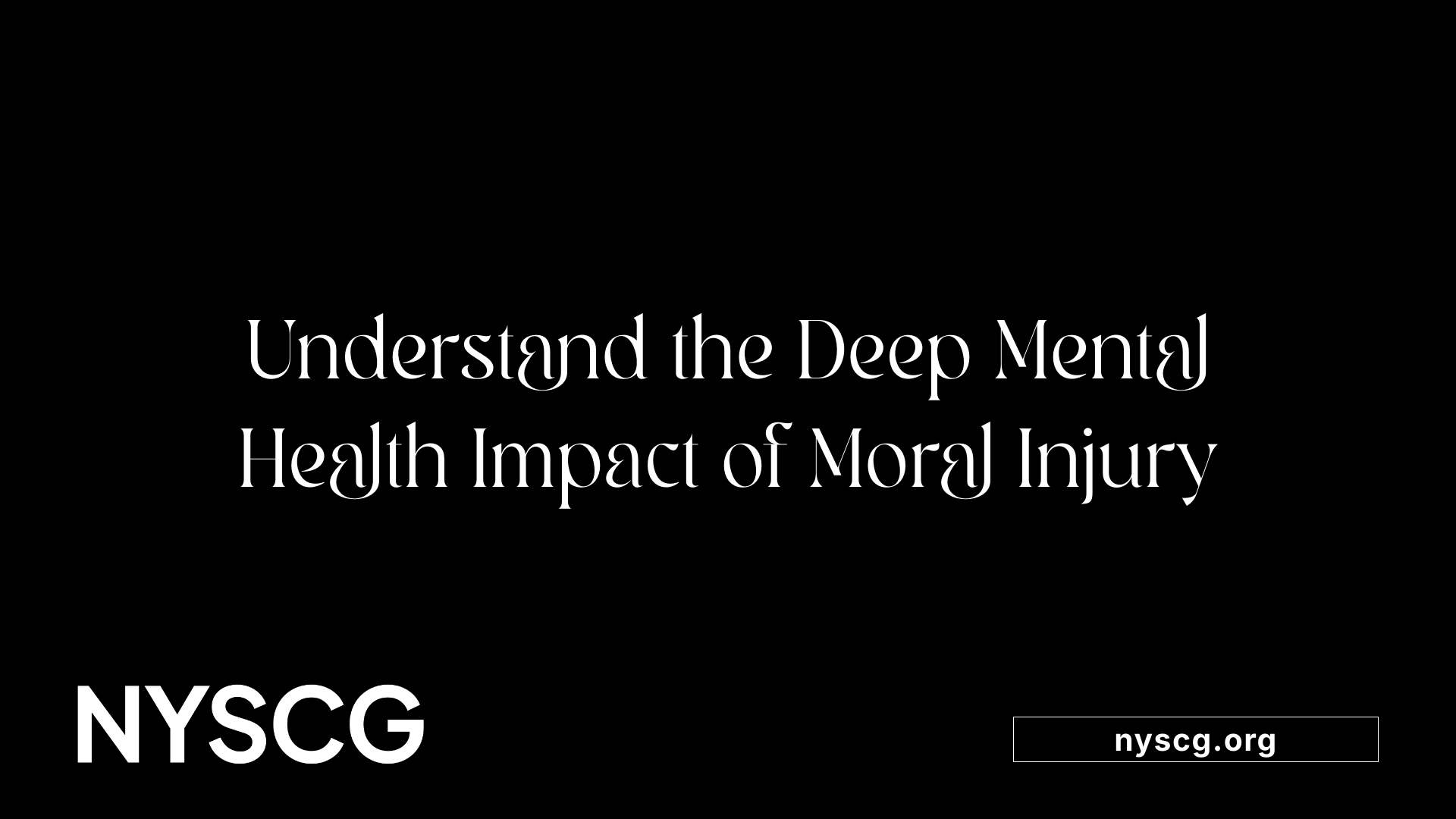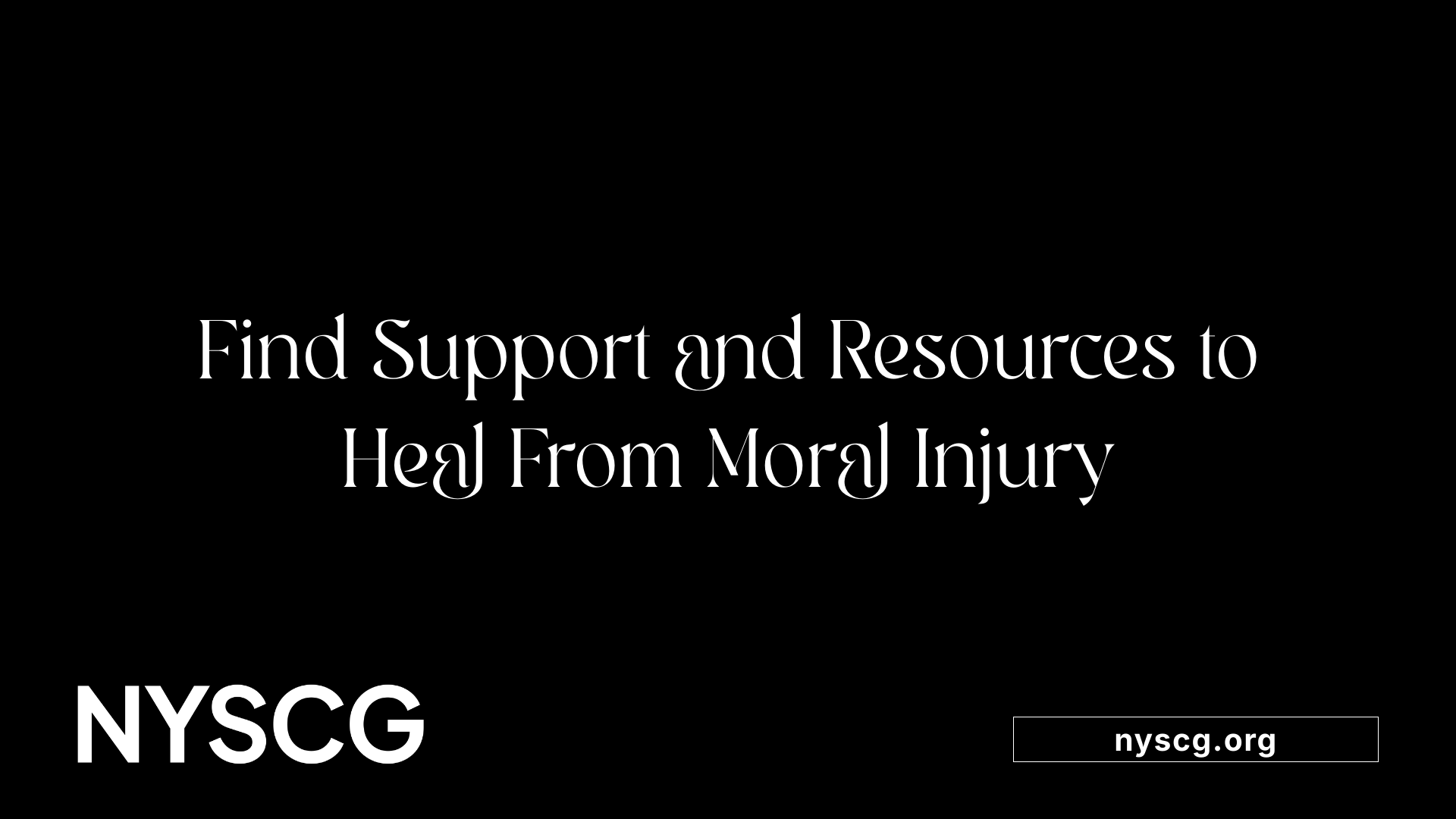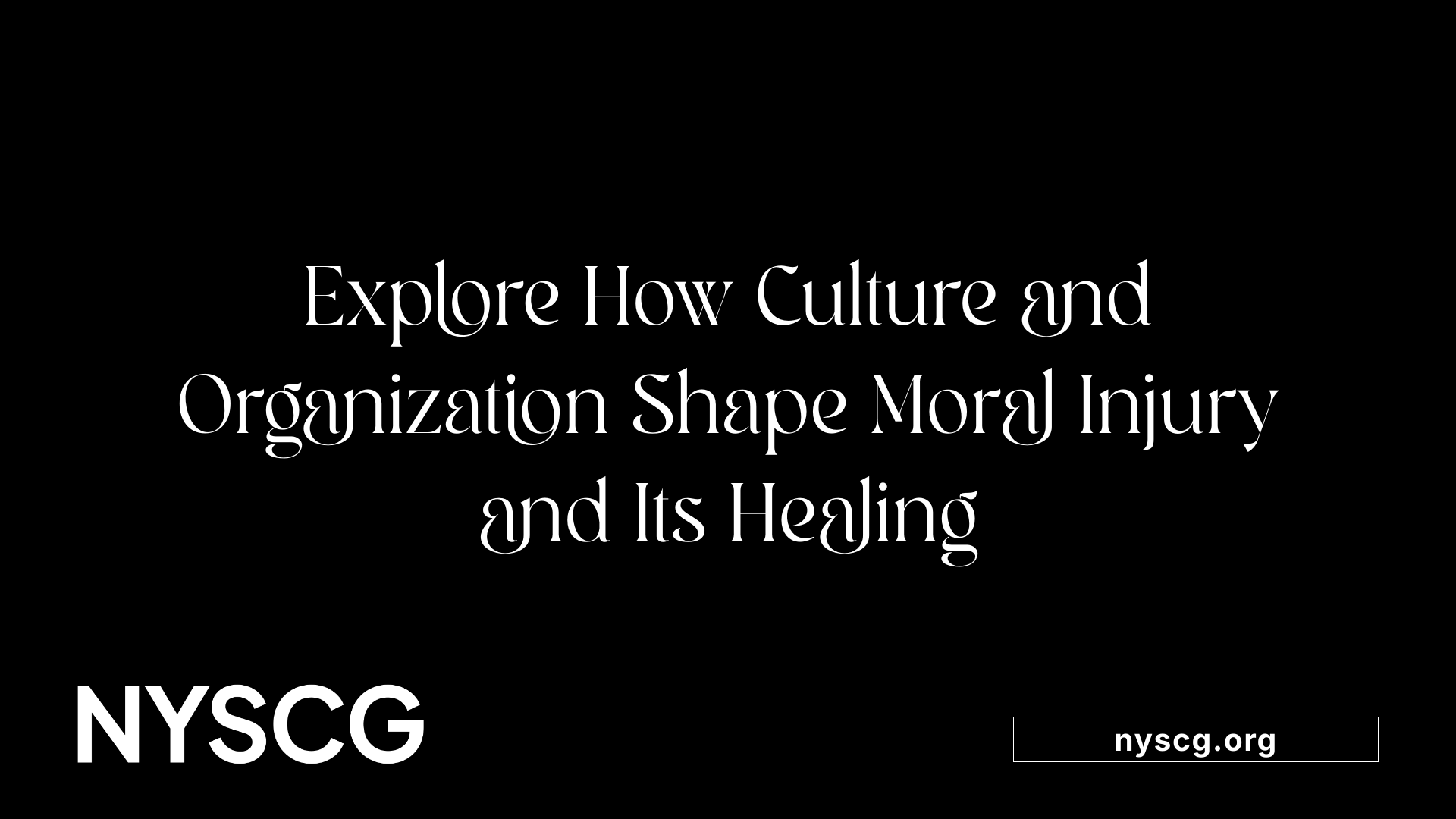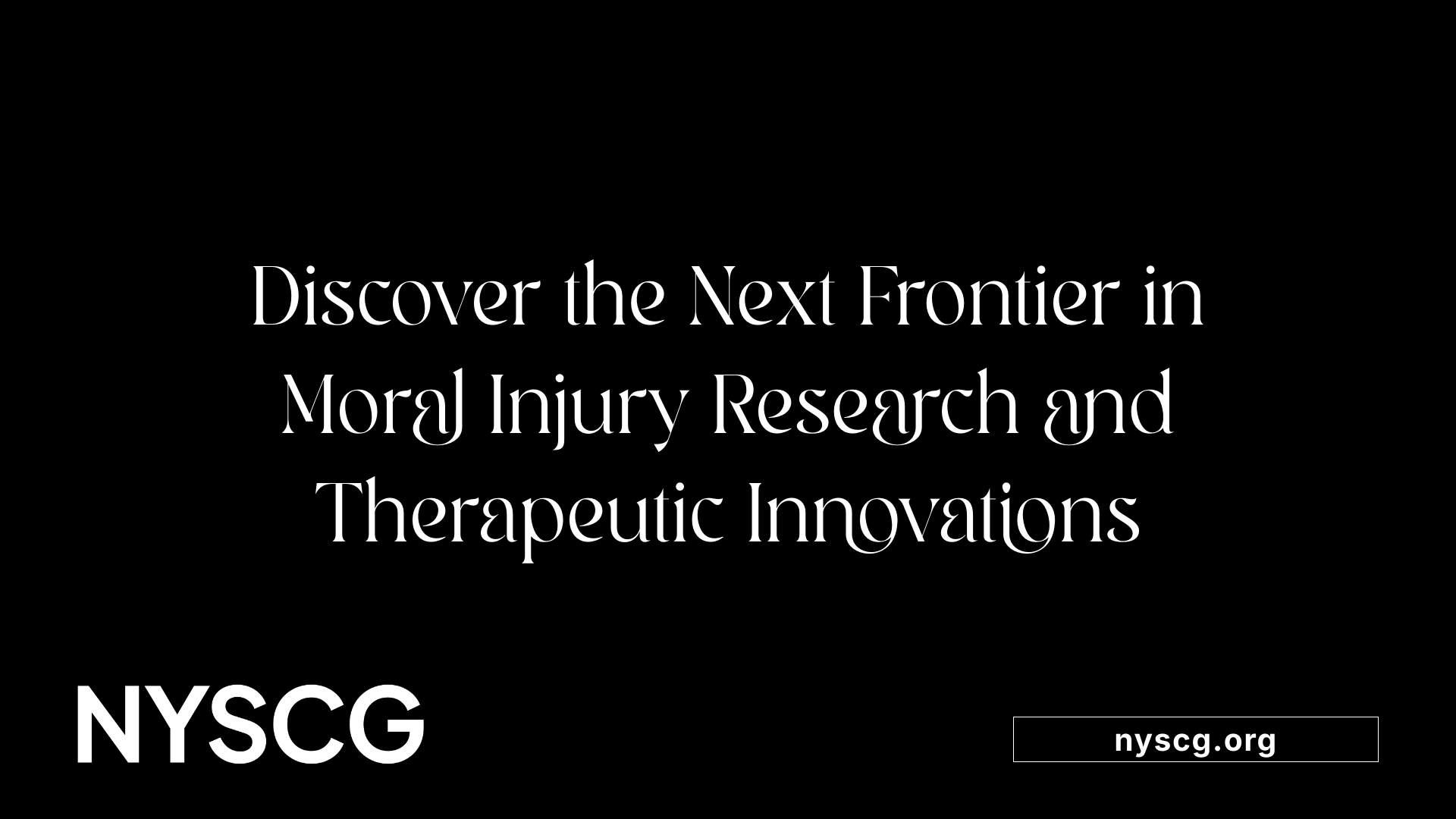Addressing Moral Injury in Law Enforcement and Veterans


Moral injury is a profound psychological, emotional, and spiritual distress resulting from actions, inactions, or witnessing events that violate deeply held moral beliefs. Its relevance spans sectors including law enforcement, military service, healthcare, and community safety. Recognizing and addressing moral injury is crucial for fostering resilience, mental health recovery, and organizational wellbeing in environments where intense moral dilemmas are frequent.
Moral injury is a form of psychological and spiritual distress that occurs when a person commits, witnesses, or fails to prevent actions that violate their core moral beliefs. It often arises in high-stakes environments like war zones or law enforcement settings, where individuals are faced with morally complex decisions.
For military personnel and law enforcement officers, moral injury can develop after experiences such as harming others, failing to act, or feeling betrayed by leaders or peers. These events lead to feelings of guilt, shame, anger, and disillusionment, which may overshadow symptoms typical of trauma, such as fear or hyper-vigilance.
The impact extends beyond mental health, affecting personal relationships, spiritual beliefs, and job performance. Many affected individuals report losing trust in themselves, others, or a higher power. Over time, moral injury can contribute to depression, social withdrawal, substance abuse, and increased risk of suicidal thoughts.
While both moral injury and PTSD can result from traumatic events, their focus differs. PTSD primarily involves hyperarousal, re-experiencing traumatic memories, and fear. Conversely, moral injury centers on feelings of regret, shame, and betrayal stemming from actions or failures that conflict with one’s moral code.
The effects of moral injury often disrupt an individual’s personal life, leading to estrangement from loved ones, loss of faith, and diminished life purpose. Professionally, it can cause job dissatisfaction, burnout, and high turnover rates, especially in demanding roles like policing and military service.
To address moral injury effectively, tailored therapeutic approaches such as Acceptance and Commitment Therapy (ACT), EMDR, or spiritually integrative treatments are increasingly being utilized. These interventions aim to help individuals process their experiences, rebuild trust, and restore their sense of moral integrity.
Moral injury in law enforcement officers and military veterans usually stems from exposure to high-stakes situations that conflict with their moral beliefs. For instance, officers might be ordered to use force that they consider excessive, or they might witness colleagues engaging in misconduct. Veterans, on the other hand, may experience moral injury through actions taken during combat, such as harming civilians, or by feelings of betrayal from leadership or peers.
The primary causes involve acts of commission, where individuals do something against their moral code, or acts of omission, where they fail to intervene or prevent morally troubling events. Betrayal by trusted figures or organizations further complicates the injury, intensifying feelings of mistrust and disillusionment.
Symptoms associated with moral injury are diverse and impactful. Common emotional reactions include persistent guilt, shame, anger, and sadness. Many also experience spiritual or existential crisis, losing their sense of meaning or faith. Social withdrawal and difficulty trusting others are frequent behavioral signs, alongside emotional numbness or paralysis. These symptoms can last for years, impairing mental health, damaging relationships, and reducing overall well-being.
Addressing moral injury effectively involves understanding these causes and symptoms to develop appropriate interventions. Therapeutic approaches may include counseling, spiritual care, and community support tailored to restore moral integrity, rebuild trust, and foster resilience among those affected.

Moral injury deeply affects an individual's psychological state and overall well-being. Those experiencing moral injury often grapple with intense feelings of guilt, shame, and anger, which can lead to emotional distress and spiritual struggles. These feelings may impair a person’s sense of trust and meaning, especially if they involve actions or events that violate their fundamental moral beliefs.
Research indicates that moral injury increases the risk of depression, anxiety, and post-traumatic stress disorder (PTSD). It can also elevate the likelihood of suicidal thoughts and behaviors, particularly if the person feels overwhelmed by guilt or betrayal. The impact extends beyond individual feelings, often manifesting as social withdrawal and strained relationships, further isolating the affected person.
Unlike PTSD, which typically features hyper-vigilance and fear, moral injury centers on moral and spiritual conflicts. Its effects may persist long after the traumatic event, making recovery complex. Therapeutic approaches targeting moral injury often include trauma-focused therapy, emphasizing forgiveness, self-compassion, and finding renewed purpose. Addressing moral injury holistically is crucial for restoring mental health and supporting long-term recovery.
Treating moral injury requires a multifaceted approach that considers emotional, spiritual, and social dimensions. Evidence-based psychotherapies like Acceptance and Commitment Therapy (ACT) and Trauma Informed Guilt Reduction have shown promise in helping individuals process feelings of guilt, shame, and betrayal. These therapies focus on accepting difficult emotions and fostering compassion and forgiveness.
In addition to individual therapy, group interventions such as Moral Injury Group therapy provide safe spaces for sharing experiences and building social support. Integrating spiritual or religious counseling can address existential questions and restore a sense of purpose.
Innovative methods are also emerging. Online therapy platforms increase accessibility, especially for those in remote areas or hesitant to seek in-person care. Scenario-based supported interventions, which simulate moral dilemmas, can help individuals rehearse ethical decision-making and coping strategies.
Digital health technologies, including virtual reality and even deepfake confrontations, are being explored to facilitate exposure therapy in controlled settings.
Assessment tools like the Moral Injury Outcomes Scale (MIOS) enable clinicians to systematically evaluate the severity and impact of moral injury. This helps tailor treatment plans to individual needs.
Combining these approaches—individual and group therapies, social and spiritual support, and innovative technology—forms a comprehensive strategy for healing. Collaboration with interdisciplinary teams that incorporate ethical, spiritual, and cultural perspectives enhances the effectiveness of interventions.
Research continues to expand the repertoire of effective therapies, ensuring that diverse populations—including military personnel, healthcare workers, and refugees—receive culturally responsive and holistic care.
Assessment tools such as the Moral Injury and Distress Scale (MIDS) and the Moral Injury Events Scale (MIES) serve as crucial resources in detecting moral injury across different populations, including military personnel, healthcare workers, and law enforcement officers.
These instruments evaluate exposure to potentially morally injurious events (PMIEs) and measure the severity of related symptoms. They typically feature brief, self-report questionnaires that respondents complete by rating statements on Likert scales. This method allows clinicians to gather quantitative data about emotional responses like guilt, shame, anger, and social withdrawal.
The questionnaires aim to assess various domains that moral injury impacts, including emotional, cognitive, spiritual, social, and behavioral aspects. For example, the MIES-LIP, a version adapted for legal-involved individuals, captures experiences specific to the legal context, such as witnessing or engaging in moral transgressions.
By analyzing the scores and patterns of responses, clinicians can determine whether an individual has experienced significant moral injury. High scores in specific areas might indicate persistent feelings of betrayal, failure to prevent harm, or moral violations. These findings can be complemented with clinical interviews and ongoing assessments to confirm the presence of moral injury.
Furthermore, the ongoing validation of these tools aims to establish reliable scoring thresholds, which improve diagnostic accuracy. The ability to quantify the impact of moral injury enables tailored treatment planning, ensuring that interventions address specific symptoms like guilt, shame, or existential distress.
Overall, assessment instruments are indispensable for early identification of moral injury. They help clinicians understand the extent to which moral conflicts affect an individual's psychological well-being and inform decisions regarding therapy options, such as trauma-focused therapy, acceptance-based approaches, or spiritual counseling.
Understanding and treating moral injury involves a variety of clinical approaches that are sensitive to its complex emotional, cognitive, spiritual, and moral aspects. Trauma-informed care is foundational, emphasizing the importance of creating a safe, empathetic environment where individuals can explore their feelings without judgment. This approach recognizes moral injury as a serious form of psychological trauma that warrants careful assessment and compassionate intervention.
Cognitive-behavioral therapies such as Cognitive Processing Therapy (CPT) and Acceptance and Commitment Therapy (ACT) have shown promise in addressing moral injury. CPT helps individuals challenge and modify unhelpful beliefs related to guilt, shame, and betrayal. ACT encourages acceptance of difficult emotions and promotes committed action aligned with personal values, fostering moral flexibility and resilience.
Specialized interventions like Adaptive Disclosure and Trauma-Informed Guilt Reduction Therapy are tailored to address specific moral conflict themes. These therapies incorporate mechanisms for forgiveness, moral reconciliation, and meaning-making, which are vital for healing moral wounds.
Assessment tools such as the Moral Injury Outcomes Scale (MIOS) provide clinicians with insights into the severity and nature of moral injury, facilitating targeted treatment plans. These instruments evaluate dimensions such as guilt, shame, spiritual distress, and trust, offering a comprehensive understanding of the individual's moral and spiritual struggles.
Theoretical models often describe moral injury as a process involving multifaceted stages—from exposure to morally injurious events, experiencing psychological and spiritual stress, to potential disorientation. Stressing the development of cognitive flexibility, these models suggest that promoting moral resilience can prevent or reduce the impact of moral injury.
Addressing moral injury effectively often requires an integrated approach that combines individual therapy, organizational support, and spiritual or community-based resources. Such a multidisciplinary strategy recognizes the importance of restoring moral integrity, fostering forgiveness, and facilitating meaning-making.
In summary, these clinical frameworks and assessment tools enable healthcare professionals to tailor interventions that promote healing, moral reconciliation, and resilience, ultimately supporting those affected by moral injury in their recovery journeys.

People experiencing moral injury have access to a variety of tools and services designed to promote healing and resilience. Mental health services form the foundation of recovery, including specialized individual therapy sessions, group counseling, and trauma-informed care programs offered by organizations such as the University of California, San Francisco (UCSF) support initiatives and local community mental health providers.
Educational resources are also widely available to help individuals understand moral injury, differentiate it from PTSD, and gain insight into their experiences. The Atlas Institute, for example, provides comprehensive guides, articles, and case studies tailored to veterans, healthcare workers, law enforcement, and other affected groups. These materials serve to educate both individuals and clinicians about the nature of moral injury and effective treatment strategies.
Community organizations play a vital role in addressing moral injury by fostering connection and support. The Moral Injury Network facilitates community-building activities, advocacy efforts, and offers surveys to help individuals identify and acknowledge their experiences. These groups aim to combat feelings of betrayal, guilt, and shame by creating a sense of shared understanding and promoting mutual aid.
Peer support groups and community-based activities are essential components of recovery efforts. They encourage open dialogue, shared storytelling, and mutual forgiveness, which are critical for overcoming emotional wounds. Many organizations offer toolkits, online webinars, and resource packets that include coping strategies such as lament, forgiveness practices, and social connectedness exercises.
In addition, resources that focus on spiritual care and social connection—such as chaplaincy services—even in secular settings, help individuals reconnect with their morals or higher purpose. The aim of these support mechanisms is to empower individuals to find meaning, restore trust, and rebuild their lives after morally injurious events.
Education plays a vital role in reducing the impact of moral injury by increasing awareness and fostering a proactive approach to mental health. By understanding what moral injury is and how it manifests, individuals in high-stakes professions—such as healthcare workers, law enforcement officers, teachers, and military personnel—can recognize early signs like guilt, shame, anger, or feelings of betrayal.
Furthermore, educational initiatives help reduce stigma associated with moral distress. When trauma and moral injury are openly discussed and validated, individuals feel more comfortable seeking help and sharing their experiences.
Equipped with knowledge, organizations can implement systemic changes to address underlying causes of moral injury. For example, understanding how policies, organizational culture, or systemic injustices contribute to moral dilemmas enables institutions to initiate reforms that prevent morally injurious events.
In addition to prevention, education supports recovery by fostering empathy and community support. It encourages affected individuals to engage in therapeutic interventions, such as counseling or peer support, knowing their experiences are recognized and treatable.
Ultimately, well-designed educational programs empower individuals and organizations alike. Early recognition of symptoms combined with destigmatization creates a safer environment where moral injury can be addressed proactively.
Educational strategies further encompass training on ethical decision-making and resilience building, preparing individuals to better handle moral dilemmas before they escalate into injury. Such comprehensive education supports long-term well-being and helps foster a culture of openness and systemic accountability.

Addressing moral injury effectively requires a nuanced understanding of cultural and organizational differences. Cultures vary widely in their moral frameworks, spiritual beliefs, and societal norms, all of which influence how individuals interpret and recover from morally injurious events. For instance, spiritual and religious traditions play a significant role in shaping moral resilience and healing, making culturally tailored spiritual support essential.
Organizational culture and policies also impact how moral injury is recognized and addressed. Supportive environments that promote transparency, ethical conduct, and open communication can help prevent the development of moral injury. Leadership practices and policies that encourage accountability, peer support, and mental health resources foster a culture of care and moral integrity.
Cross-cultural research underscores the importance of adaptable interventions that respect local morals, beliefs, and social values. Customizing therapeutic approaches—such as culturally relevant counseling, community-based support programs, and locally appropriate educational initiatives—can greatly enhance the relevance and effectiveness of treatment.
Furthermore, developing resources that respect cultural and spiritual norms ensures that individuals feel understood and supported. Training programs designed to increase moral awareness and resilience should incorporate local moral codes and social practices.
Ultimately, fostering moral resilience and facilitating recovery in diverse populations involves combining culturally sensitive support with organizational commitment to ethical practice and mental well-being. Recognizing and integrating cultural differences not only improves therapeutic outcomes but also promotes a broader understanding of moral injury worldwide.

Research in moral injury is moving towards a broader understanding of its presence across different cultures, professions, and communities. Future studies aim to develop more sensitive assessment tools that can accurately measure the severity and nuances of moral injury, allowing for personalized treatment plans.
Innovations in technology are opening new avenues for support. Web-based therapy programs, virtual reality (VR) environments, and digital peer support networks are being developed to reach individuals who might otherwise face barriers to traditional mental health services. These tools are especially promising for military veterans, first responders, and individuals in remote areas.
Integrating spiritual and community-oriented therapies is also gaining importance. Recognizing the role of meaning-making, forgiveness, and social connection helps foster profound recovery. Combining these approaches with evidence-based practices creates holistic treatment options that address emotional, spiritual, and social dimensions.
Advances in neuroscience, including neurofeedback and the identification of biological markers, are set to deepen our understanding of the brain mechanisms involved in moral injury. This knowledge could lead to targeted interventions that promote brain health and resilience.
Altogether, these directions suggest a future where treatment for moral injury is more personalized, accessible, and culturally sensitive. Emphasizing an interdisciplinary approach that incorporates technological, spiritual, and social innovations offers hope for those affected by deep moral wounds.
Addressing moral injury comprehensively requires a concerted effort across individual, organizational, and societal levels. Education, early intervention, tailored therapies, and systemic reforms are critical for promoting healing among law enforcement officers, veterans, and other high-risk groups. Cultivating a culture of openness, moral resilience, and support can reduce stigma and foster recovery. By integrating innovative research, technology, and community resources, organizations can better prevent, identify, and treat moral injury. Ultimately, healing from moral injury not only restores individual well-being but also enhances trust, ethical integrity, and cohesion within communities and institutions.
All you need is the will to make the world a better place.
New York State chaplain group inc. is a tax deductible organization with a federal tax Id number 92-383-4921